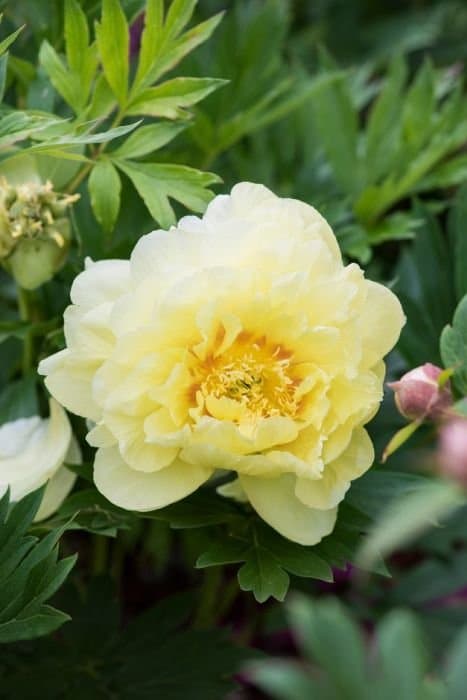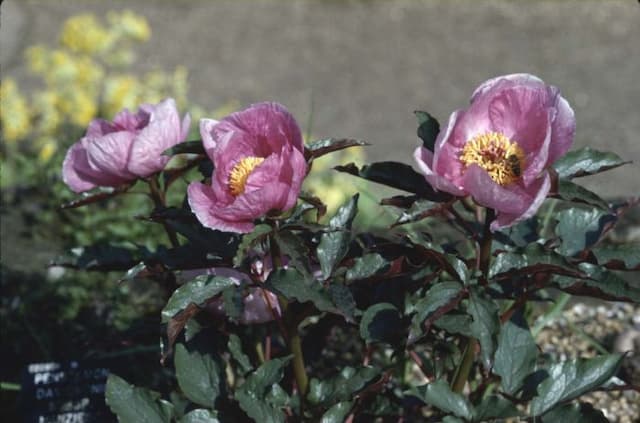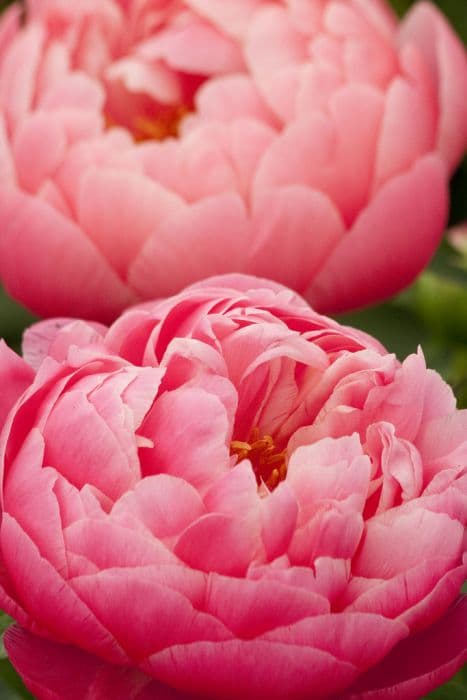Chinese peony Paeonia lactiflora 'Augustin d'Hour'

ABOUT
The plant commonly known as the Chinese peony 'Augustin d'Hour' is a highly ornamental perennial that boasts large, lush flowers. Its showy blooms are a captivating deep reddish-pink, often described as magenta or fuchsia, which makes them stand out in any garden setting. Each flower is composed of layers of ruffled petals that surround a central cluster of golden-yellow stamens, creating a striking contrast that is visually appealing. The petals have a soft, satiny texture and may exhibit a slight sheen that catches the light, adding to the plant's overall radiance. The foliage of 'Augustin d'Hour' is also quite attractive, with glossy, dark green leaves that provide a perfect backdrop to the vivid flowers. The leaves are typically divided into several leaflets, which are further sub-divided into elegantly lobed smaller leaflets, creating a fine, feathery appearance. This peony variety exudes a delightful fragrance that is both sweet and slightly spicy, making it not only a treat for the eyes but also for the olfactory senses. The scent can attract pollinators and can perfumes the air in the surrounding area, adding another layer of enjoyment to the garden experience. As a perennial, the Chinese peony 'Augustin d'Hour' returns year after year, each time bringing with it the promise of spectacular spring to early summer blossoms. Cultivated for its stunning flowers and pleasant aroma, it is often a focal point in floral gardens and is also popular for cut flower arrangements, where its blooms can be enjoyed indoors.
About this plant
 Names
NamesSynonyms
Chinese Peony, White Peony.
Common names
Paeonia lactiflora 'Augustin d'Hour'.
 Toxicity
ToxicityTo humans
Peony (Paeonia lactiflora 'Augustin d'Hour') is generally considered non-toxic to humans. However, like many plants, it may cause mild stomach upset if ingested in large quantities. Skin contact with peonies can sometimes cause irritation due to the presence of a compound called paeonol. The most common consequences of ingestion are usually gastrointestinal discomfort, such as nausea or diarrhea.
To pets
Peony (Paeonia lactiflora 'Augustin d'Hour') is considered toxic to pets, particularly cats and dogs. If a pet ingests peony, they might experience symptoms such as vomiting, diarrhea, or drooling. In severe cases, it could lead to depression of the central nervous system. It is advised to keep these plants out of reach of pets to avoid these potential issues.
 Characteristics
CharacteristicsLife cycle
Perennials
Foliage type
Deciduous
Color of leaves
Green
Flower color
Pink
Height
2-3 feet (60-90 cm)
Spread
2-3 feet (60-90 cm)
Plant type
Herb
Hardiness zones
3-8
Native area
Asia
Benefits
 General Benefits
General Benefits- Ornamental Appeal: Paeonia lactiflora 'Augustin d'Hour', commonly known as Chinese peony, provides aesthetic value to gardens with its large, showy flowers.
- Landscape Versatility: This perennial is suitable for borders, and works well in both formal and cottage garden settings.
- Cut Flowers: The blooms are long-lasting in vases, making them excellent for floral arrangements.
- Seasonal Interest: Chinese peony offers spring to early summer interest, often flowering in late spring.
- Attracts Pollinators: The flowers attract bees, which are beneficial for pollinating other plants in the garden.
- Drought Tolerance: Once established, they have good drought tolerance, requiring minimal watering.
- Deer and Rabbit Resistance: They are less likely to be damaged by deer or rabbits compared to other garden plants.
- Cold Hardy: Chinese peony is cold-hardy and can thrive in cooler climates.
- Longevity: With proper care, these plants can live for many years, even decades, adding permanence to garden landscapes.
- Low Maintenance: Aside from basic watering and fertilizing, they require little care and are relatively disease and pest resistant.
 Medical Properties
Medical Properties- Anti-inflammatory: Paeonia lactiflora, commonly known as peony, contains paeoniflorin, a compound which may have anti-inflammatory properties.
- Immunomodulatory effects: Peony may influence the immune system modulating the body’s immune response.
- Antioxidant: It has potential antioxidant activities which help in protecting cells from oxidative stress.
- Analgesic: The plant may possess pain-relieving properties, potentially helpful in reducing discomfort.
- Neuroprotective: Extracts from peony may offer some protection to nerve cells, possibly aiding in the prevention of neurodegenerative disorders.
 Air-purifying Qualities
Air-purifying QualitiesThis plant is not specifically known for air purifying qualities.
 Other Uses
Other Uses- Culinary Decoration: The petals of the common peony can be used to add a colorful garnish to salads and desserts, offering an elegant touch to culinary presentations.
- Fabric Dye: The blooms of the common peony can be boiled to produce a natural dye for fabrics, imparting gentle hues to textiles.
- Artistic Inspiration: Artists have long been inspired by the beauty of the common peony, using it as a motif in paintings, illustrations, and textile designs.
- Wedding Decor: Owing to their lush and full appearance, common peonies are popular in wedding bouquets and centerpieces for a romantic setting.
- Fragrance Production: Common peonies are known for their pleasant scent which can be extracted and used in the making of perfumes and scented candles.
- Eco-Friendly Confetti: Dried petals of the common peony can serve as a biodegradable alternative to traditional paper confetti in celebrations.
- Photography: The common peony, with its rich textures and colors, is often featured in botanical photography to capture the essence of spring and floral beauty.
- Companion Planting: Common peonies can be planted alongside certain vegetables to help deter pests from the garden without the use of chemicals.
- Craft Material: Dried peony petals and leaves can be incorporated into various crafts such as making paper, potpourri, or pressed flower art.
- Education and Research: Known for their diverse genetics, common peonies are studied for their evolutionary adaptations, providing insight into plant biology and breeding.
Interesting Facts
 Feng Shui
Feng ShuiPeonies are often used in Feng Shui to attract love and romance, and they can be placed in the southwest corner of a garden or home to enhance these aspects of a person's life. The white peony, being a symbol of purity and innocence, might add a calming and stabilizing energy to an environment.
 Zodiac Sign Compitability
Zodiac Sign CompitabilityThe peony is not used in astrology practice.
 Plant Symbolism
Plant Symbolism- Prosperity: The Paeonia lactiflora, commonly known as Chinese Peony, is often associated with wealth and prosperity due to its full, opulent blooms.
- Romance: Chinese Peonies are symbolic of romance and romantic love, with lush flowers that are reminiscent of the idealized emotions found in love stories.
- Honor: The flower represents honor and high value, which is why it is often used in celebratory occasions and to show respect to others.
- Beauty: With its attractive and delicate flowers, the Chinese Peony is also a symbol of beauty in many cultures, celebrating the aesthetic and the pleasing in nature.
- Good Luck: In some traditions, Chinese Peonies are believed to bring good luck, particularly in terms of good fortune and a happy marriage.
 Water
WaterPeonies, such as the Paeonia lactiflora 'Augustin d'Hour', prefer even moisture during the growing season, especially when buds are forming. Generally, an established peony plant should be watered once a week, with about 1 gallon of water per plant, ensuring deep watering that reaches the roots. During the hot summer months or in particularly dry climates, the frequency may need to increase. It's vital to avoid waterlogging, as peonies do not like wet feet and can suffer from root rot if overwatered. As the peony heads into fall and winter dormancy, reduce watering to help the plant harden off.
 Light
LightPeonies like Paeonia lactiflora 'Augustin d'Hour' thrive in full sun, meaning they should receive at least 6 hours of direct sunlight daily. Planting them in a spot where they can bask in morning light and are protected from the harsh afternoon sun can help prevent petal burn. A location that offers bright, indirect light for the rest of the day is ideal to ensure strong stems and vibrant blooms.
 Temperature
TemperaturePeonies, including Paeonia lactiflora 'Augustin d'Hour', do well in a wide range of temperatures, but they require cold winter periods for dormancy. The ideal growing temperatures range between 65°F and 75°F during their active growing season. They can survive winter temperatures down to roughly -20°F. Peonies are resilient to late frosts, but it's best to protect early shoots from extreme cold snaps below this range.
 Pruning
PruningPeonies such as Paeonia lactiflora 'Augustin d'Hour' are pruned to remove spent blooms and to shape the plant. Deadheading after flowering encourages healthy growth and prevents seed development, which can drain energy from the plant. In fall, after the foliage has died back, cut the stems down to about 3 inches above ground level to prepare for winter. Pruning is typically done annually during these times.
 Cleaning
CleaningAs needed
 Soil
SoilChinese Peony thrives in well-drained, loamy soil with a pH of 6.5 to 7.0. A mix of two-thirds garden soil and one-third compost or well-rotted manure works best. Add a handful of bone meal to encourage root development.
 Repotting
RepottingChinese Peonies like 'Augustin d'Hour' rarely need repotting; they prefer to be left undisturbed and can remain in the same location for many years.
 Humidity & Misting
Humidity & MistingChinese Peonies, such as 'Augustin d'Hour', tolerate a wide range of humidity levels and do not require specific humidity conditions for optimal growth.
 Suitable locations
Suitable locationsIndoor
Not suitable for indoor growth; requires outdoor conditions.
Outdoor
Plant in sun, fertile, well-drained soil; water deeply, mulch.
Hardiness zone
3-8 USDA
 Life cycle
Life cyclePaeonia lactiflora 'Augustin d'Hour', commonly known as the Chinese peony, begins its life cycle as a dormant tuberous root in winter. In early spring, reddish shoots emerge from the soil and develop into large, green, divided leaves, with the plant eventually reaching up to 2-3 feet in height. By late spring or early summer, it produces large, fragrant flowers that can be pink, red, white, or multicolored, attracting pollinators such as bees. After blooming, the plant sets seed in the form of a capsule that, once mature, splits open to release the seeds. In autumn, the foliage turns a golden yellow before dying back to the ground, entering a period of dormancy as the plant conserves energy for the next growing season. The tuberous root survives underground throughout the winter, ready to regenerate the following spring.
 Propogation
PropogationPropogation time
Early spring
Propogation: Paeonia lactiflora 'Augustin d'Hour', commonly known as Chinese peony, is most popularly propagated by division, which is best done in the fall after the plants have gone dormant. To propagate by division, carefully dig up the peony clump and gently shake off the soil. Using a sharp knife or garden spade, divide the clump into sections, ensuring that each section has 3-5 eyes, which are the pink or white buds that will become next year’s shoots. Replant the divisions immediately at a depth where the eyes are about 1-2 inches (2.5-5 cm) below the soil surface, allowing for adequate root development before the ground freezes. Water the new plants thoroughly to settle the soil around the roots and help eliminate air pockets.









